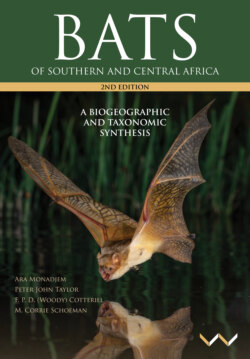Читать книгу Bats of Southern and Central Africa - Ara Monadjem - Страница 37
На сайте Литреса книга снята с продажи.
Drainage systems
ОглавлениеThe modern hydrology of southern Africa is dominated by several major drainage basins, with the Congo and Cuanza basins in the extreme north, the Zambezi and Limpopo rivers, which drain eastwards into the Indian Ocean, and the Kunene and Orange–Vaal systems that drain west into the Atlantic (Figure 24). River topology strongly influences the distributions of bat species that depend on riparian habitats for food and daylight roosts. This can be seen very clearly in the Namib Desert, where the Kuiseb River supports populations of tree-roosting bats.
The drainage systems that characterise southern Africa today are very different from their precursors. Repeated uplift and erosion of the Kalahari Plateau and the propagation of the East African Rift System into southern Africa caused radical rearrangements of the region’s drainage systems.
Following the final stages in the break up of Gondwana (∼127 Ma), the Palaeo-Limpopo River drained a large part of the interior of central southern Africa, with most of the rivers of today’s lower DRC, Angola, Botswana and Zimbabwe flowing into it. About 80 Ma, epeirogenic uplift created vast depressions across the Kalahari Plateau Basin in the interior of southern Africa. What are today the headwaters of the Kunene, Orange, Limpopo and Zambezi rivers originally flowed into the Kalahari Basin (Moore et al. 2009). These endorheic rivers maintained vast lakes in the interior, notably in the Etosha basin and northeastern Botswana; one of the largest of these lakes was Palaeo-Lake Makgadikgadi, which had an area of ∼67,000 km2 (Cotterill 2006, Moore et al. 2012).
Figure 23. The view north along the western escarpment of the Tanganyika graben, northeastern Zambia, illustrates the dramatic topography expressed along the East African Rift System. The vegetation is dominated by miombo woodland, with gallery and scarp forest, and also includes Itigi thicket on the valley floor (© F. P. D. Cotterill).
The southwest propagation of the East African Rift System into southern Africa had a marked influence on the development of the Zambezi River System. Concomitant with this rifting, the Zambezi and its tributaries incised deeply westwards across the eastern rim of the Kalahari Plateau, capturing several of the rivers that were feeding the palaeo-lakes. This prolonged episode began with the Zambezi’s piracy of the Palaeo-Luangwa, and its most recent piracies of the Upper Zambezi and Upper Kafue rivers (Moore et al. 2009, 2012, 2020). The Proto-Congo and Middle Zambezi rivers expanded their catchments significantly through the piracy of most of the large endorheic rivers. Continued tectonism on the Kalahari Plateau, associated with tectonism along the East African Rift System, also led to the diversion of the Kwando (= Chobe) River into the Zambezi River. Today, the only large endorheic rivers still draining into the Kalahari Basin are the Cubango and Quito, which form the Okavango Delta in northern Botswana (Goudie 2005, Cotterill 2006, Moore et al. 2009, 2012) (Figure 24).
Figure 24. The extent of the elevated expanse of the Kalahari Plateau is depicted in this computer-generated Digital Elevation Model (DEM). Situated south of the Congo basin, the Kalahari Plateau is bounded by flanking coastal escarpments, and has been greatly altered by the East African Rift System (notably the Gwembe-Luangwa valleys) (Generated from the SRTM-3 (Shuttle Radar Topographic Mapping 3) dataset compiled by NASA, with annotations, including locations of principal cities; © F. P. D. Cotterill, AEON).
These dynamic drainage systems are landforms of central significance to palaeobiological and geological research, because their history provides invaluable keys to decipher the complexities of landscape evolution. Although comparatively subtle, these changes have profoundly influenced the distribution and evolution of Africa’s fauna, including bats (Cotterill 2003, 2004, 2005, Moore et al. 2009, 2012, 2020).
